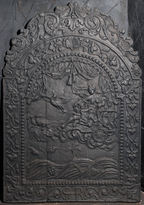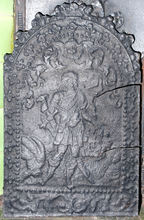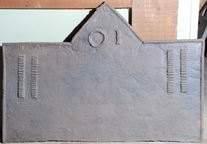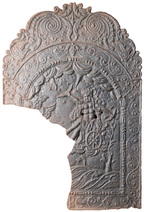-
327
Description: Arched rectangular shaped central panel with open-bud edging; pictorial: Venus in her chariot drawn by doves, with her child, Cupid; a heron flies away to the left; above are swagged curtains and a pair of tassels, below is a landscape; arched rectangular shaped border with fillet edging, a scallop shell top centre with symmetrical arrangement of vine and acanthus leaves and tendrils; the monogram, SHR, bottom centre; above is a symmetrical design of scrolled floral tendrils.
Notes: The design is derived from a personification of the planet Venus in 'Planetarum effectus et eorum in signis zodiaci', by Marten de Vos (1585). Two editions of engravings of de Vos's drawings are known, by Jan Sadeler, dated 1585, and by Gregor Fentzel in about 1650. The flying heron has been copied from a print by Wenceslaus Hollar c.1658. The theft, in 1699, from a Thames-side warehouse of several firebacks, included '6 of Venus in a Chariot with Doves', which is likely to refer to this type (Post Boy 11-14 Nov. 1699).
Copies of this fireback are known.
Inscription: SHR
- Decoration tags:
- 'Dutch' (shape)
- fillet (edging)
- whole carved pattern
- planklines
- pictorial
- mythological
- allegorical
- text
- animals
- humans
Manufactured: in the late-17th century in England.
Current location: Horsham Museum, Causeway, Horsham, West Sussex, England.
(part of the Horsham Museum museum group)
- Attached to series:
- SHR series
- British 'Dutch' style firebacks
- De Vos Planets series
-
328
Description: Arched rectangular central panel with bead edging; pictorial scene of a figure in Roman dress, holding a large sword, and holding the head of a bearded man in his left hand; below to the left, a naked, decapitated body; above the winged face of a putto between mirrored, scrolled foliage; arched rectangular border with fillet edging; flowers in chain under the arch and down the sides; at the bottom, swirled foliage; on top, a crown between fruit triads.
Notes: Perseus holding the severed head of the Medusa; possibly loosely adapted from a drawing by Crispijn de Passe the elder (1564-1637). Similarities in the design and execution of the pattern suggest a common source with contemporary English firebacks.
- Decoration tags:
- 'Dutch' (shape)
- fillet (edging)
- whole carved pattern
- pictorial
- mythological
- humans
Manufactured: in the early-18th century in England.
Current location: Horsham Museum, Causeway, Horsham, West Sussex, England.
(part of the Horsham Museum museum group)
- Attached to series:
- British 'Dutch' style firebacks
-
329
Description: Arched rectangular shape; simulated twisted rope edging (top & sides); central, symmetrical arrangement of a fleur-de-lys between two diamond stamps with two small cross-cut squares below, and a triad of dots outside; above, a haphazard arrangement of date, at top, above the initials, with a rose and crown to the left, and another fleur to the right.
Notes: Almost certainly an altered copy of a similar fireback dated 1613, some of the features of which have remained.
Inscription: 1637 / ILE
- Decoration tags:
- rectangular with round arch (shape)
- simulated rope (edging)
- carved stamps
- individual letters
- individual numbers
- heraldic
- text
Manufactured: in 1637 in the Weald area of England.
Current location: Horsham Museum, Causeway, Horsham, West Sussex, England.
(part of the Horsham Museum museum group)
- Attached to series:
- Diamond series
-
330
Description: Rectangular; plain edge; top centre, ring between repeated lion's head between repeated narrow human figure with folded arms standing on a bracket; below each figure, a small bracket.
Notes: The figures are indistinct and are disproportionately small for the size of the firebacks; from Isfield Place 1921.
- Decoration tags:
- rectangular (shape)
- none (edging)
- simple stamps
- carved stamps
- animals
- humans
- objects
Manufactured: in the late-19th to early-20th century in England.
Current location: Horsham Museum, Causeway, Horsham, West Sussex, England.
(part of the Horsham Museum museum group)
- Attached to series:
- Miscellaneous stamp firebacks
-
331
Description: Rectangular; no edging; inscription evenly spaced along top, sans serif lettering.
Inscription: IS D T IS
- Decoration tags:
- rectangular (shape)
- none (edging)
- carved stamps
- individual letters
- text
Manufactured: in the late-19th to early-20th century in England.
Current location: Horsham Museum, Causeway, Horsham, West Sussex, England.
(part of the Horsham Museum museum group)
- Attached to series:
- Initials only firebacks
-
332
Description: Arched rectangular shape; cavetto moulded edging; top centre within arch, initials above date.
Notes: Plain elegant fireback from a late series, probably cast in the south east of England. The crack emanating from the top right corner of the fireback seems to be a weakness on all the recorded examples, and may have caused by thinness of the base board at that point.
Inscription: TW / 1852
- Decoration tags:
- rectangular with round arch (shape)
- cavetto (edging)
- individual letters
- individual numbers
- text
Manufactured: in 1852 in England.
Current location: Horsham Museum, Causeway, Horsham, West Sussex, England.
(part of the Horsham Museum museum group)
- Attached to series:
- 1850s series
-
333
Description: Rectangular with triangular extension at middle of top edge; rope edging (top and sides); inscription in triangle - O larger than I; a pair of vertical, parallel ratchet bars (180mm long) below each top corner.
Inscription: O I
- Decoration tags:
- rectangular with triangular arch (shape)
- rope (edging)
- simple stamps
- text
- objects
Manufactured: in the late-16th to early-17th century possibly in the Weald area of England.
Current location: Horsham Museum, Causeway, Horsham, West Sussex, England.
(part of the Horsham Museum museum group)
- Attached to series:
- Miscellaneous stamp firebacks
-
325
Description: Arched rectangular shaped central panel with bead-and-pellet edging on a broad fillet; Jupiter in his chariot drawn by eagles; above are clouds, below is a landscape; arched rectangular shaped border with fillet edging, with a symmetrical scrolled wire design; the monogram, SHR, bottom centre; above is a symmetrical design of scrolled floral tendrils.
Notes: The design is probably adapted from a personification of the planet, Jupiter, in 'Planetarum effectus et eorum in signis zodiaci', by Marten de Vos (1585). Two editions of engravings of de Vos's drawings are known, by Jan Sadeler, dated 1585, and by Gregor Fentzel in about 1650.
Inscription: SHR
- Decoration tags:
- 'Dutch' (shape)
- fillet (edging)
- whole carved pattern
- pictorial
- mythological
- allegorical
- text
- humans
Manufactured: in the late-17th to early-18th century in England.
Current location: Horsham Museum, Causeway, Horsham, West Sussex, England.
(part of the Horsham Museum museum group)
- Attached to series:
- SHR series
- British 'Dutch' style firebacks
- De Vos Planets series







